02: Choosing Rigs
Between The Lines - Ch 05: Rigs
The combinations of lures and rigs are infinite. It is one of those club room subjects often argued for hours at a time. There is no need for this confusion as it really is very simple matter of basic physics and hydrodynamics. There are thousands of head types and shapes used in lure trolling but they can be broken up into just two basic categories:
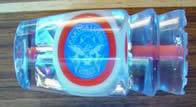
Symmetrical Heads are heads that are the same shape top and bottom for the length of the lure head. The leader holes are often through the middle of the head but can have offset leader tubes. Apart from cosmetics and colour schemes they don't have a top and bottom. They are rarely weighted but can be keel weighted so they then do have a top and bottom. Pakula symmetrical heads are offered in non-weighted and keel weighted ranges. The way this type of head is rigged is critical as they determine the orientation of the lure and if the rig is wrong it can overwhelm keel weighted lures.
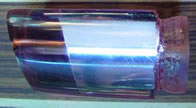
Non Symmetrical Heads are heads that are not the same top and bottom. They can be any shape, although most often these are heads with an angled front. They do have a top and bottom, although which side is top or bottom depends on design and weighting. The leader hole is often central but can be offset.
Understanding the distinction between the two will help in deciding which rig is most applicable. There are an infinite amount of rigging options and hook types, sizes and combinations. We can break them all down into just four main rigs, although while dealing with the rigs and their attributes, keep in mind the effect they would have in enhancing or disrupting the desired characteristics of the lure heads.
To know more about the rigs a short video is included in each category to show what the rig actually does underwater rather than what many people think they do.
Understanding the distinction between the two types of lure heads and their variations will help in deciding which rig is most applicable. There are an infinite amount of rigging options and hook types, sizes and combinations. We can break them all down into just five main rigs, although while dealing with the rigs and their attributes, keep in mind the effect they would have in enhancing or disrupting the desired characteristics of the lure heads.
To know more about the rigs a short video is included in each category to show what the rig actually does underwater which is often very different to what many assume their behaviour is.
Single Hook - Loose Loop Rig
Single Hook Rigs are the most common rigs used. We suggest setting the hook so only the eye of the hook is in the skirt regardless of which rig is used.
If the hook is on a loose loop it is free to balance and will run as the video shows hook point up. If it is stiff rigged the hook will more than likely spin.
When single hook on a loose loop rig is run in the water they run point up. This targets the hook point at the top jaw, which is by far the best, as it is the largest target with quite a few areas where the hooks can lodge securely. As a single hook doesn't have much weight they can be affected by turbulence speed more easily than twin hook rigs that have more weight to help stability.
Single hook rigs are seen to be the safest to use for both angler and fish alike and do result in a fairly good hook-up rate.
The single hook we recommend using in Pakula Lures is the Pakula Swivel Rig shown below.
If conditions are turbulent we suggest keeling the rig to add more weight and stability. Keel Rigs are shown further down the page.

Pakula Swivel Rig
Twin Hook Rig - Two Hooks the Same Size - Stiff Rigged
Twin hook stiff rigs with hooks the same size are the most common rigs used. They are generally stiff-rigged so the hooks remain rigid, bound by electrical tape or shrink tubing. They are portrayed as in the photo with one point up and the other down.
When twin hook rigs are run in the water they naturally run flat as the weight of each hook balances out the other. The target the hooks are aimed at is in the corner of the mouth and this is usually accomplished once the fish has turned away from the boat. This rig is also quite unstable at speed, and will rotate in any turbulence, which makes the target they are aiming at a random target.
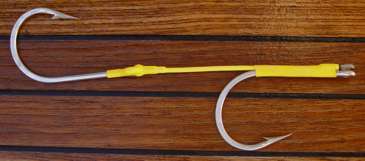
Twin Hook Rig - Two Hooks the Same Size - Stiff Rigged
Due to the nature of these rigs they are of little use with symmetrical heads. Apart from the hooks running flat, the stiff rig drastically reduces the lure action and its effectiveness. They are only of use with non-symmetrical heads and only when they have been heavily weighted and the rigged locked at the back of the lure head to try and compensate for the hooks trying to turn the lure on its side. The tendency of these hooks to roll the lure restricts the maximum-sized hooks that can be run in these lures as the weight of the heavier hooks will overcome the balance of the lure head and weight balance.
Twin Hook Rig - Hooks Different Sizes - Stiff Rigged
Twin hooks with a combination of sizes and/or types are based on using a large hook near the lure head with a small hook at the tail. They are most often stiff-rigged but are also often rigid with the large hook taped to the wire, with the trailing smaller hook rigged loosely on a wire loop.
When the combination twin hook rig is run underwater, the interaction of the two hooks sees the larger hook run with the point facing downwards and the smaller hook run with the point up. Unfortunately, this means the smaller hook is aimed at the better target of the top jaw.
When the hooks are set at 90 degree the rig is relatively stable for a stiff rig and will maintain it’s configuration at normal speeds in calm conditions.
If the hooks are set flat at 180 degrees as in the photo below the rig has a tendency to spin.
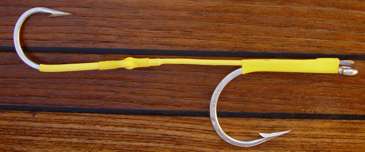
Twin Hook Rig - Hooks Different Sizes - Stiff Rigged
Twin Hook Rig with Different Sized Hooks set at 90 degrees
Twin Hook Rig with Different Sized Hooks Set at 180 Degrees
Pakula Twin Hook 60 Degree Shackle Rig
The Pakula Shackle Rig was invented to overcome the problems of rigging symmetrical-shaped heads. Both hooks are angled at 60 degrees so both hooks are separately allowed to balance with both points aimed at the top jaw. All connections are loose, the hooks on loops allows the hooks to swing freely on a shackle, which in turn gives the lure maximum freedom of action and effectiveness. When running underwater the Shackle Rig is very stable, as each hook runs as an individual, maintaining its own balance. They are by far the best for symmetrical-shaped heads as they act as a keel to keep the lure oriented with the part of the lure between the hook points running uppermost. This rig is also quite good for non-symmetrical-shaped heads as both hooks are aimed at the best target, the top jaw.

Pakula Sixty Degree Shackle Rig
Pakula Keel Rig
The ‘Keel Rig’ is a way to overcome the natural imbalance of many of the traditional systems. This modification to rigs was developed many years ago as part of the shackle rig to increase hook-up rates regardless of the hook configurations used and to overcome the effects of rough seas unbalancing even the best rigs. The rig modification is based on lowering the centre of gravity of the rigs by suspending weights below the bend of the hook.
The main considerations are that only enough lead should be used to meet the conditions. The lead keel can be fixed to the hook by binding and/or gluing.
The short video shows several keeled rigs: Firstly, the single hook rig is now very stable. Secondly, the twin hook back to back is not weighted enough to stabilise it. A bit more lead would accomplish this. The third is a shackle rig in turbulent waters maintaining its 60-degree set-up.
The keel rig increases hook-up rates significantly.

Pakula Single Hook Kell Rig
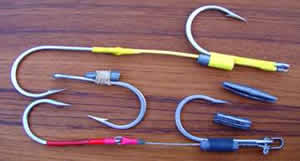
Keel Rigs Used in the Video Footage
There are many articles and how-to articles and videos on this website which can be found via the search menu at top of the page.





